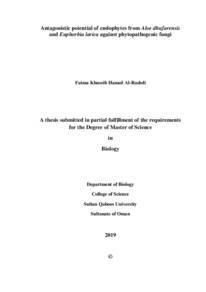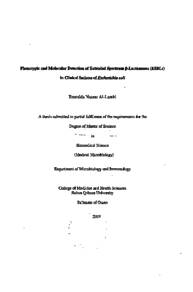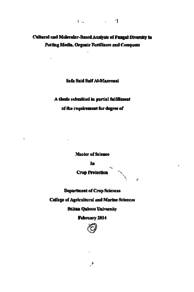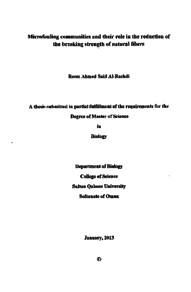Document
Antagonistic potential of endophytes from Aloe dhufarensis and Euphorbia larica against phytopathogenic fungi
Gregorian
2019
Language
English
Subject
English abstract
Aloe dhufarensis Lavranos (Asphodelaceae) and Euphorbia larica Boiss. (Euphorbiaceae) are important medicinal plants in Oman, but little is known about the endophytic microorganisms associated with these plants and their antagonistic activities. In this study endophytic fungi and bacteria were isolated from A. dhufarensis and E. larica and their antagonistic potential against fungal pathogens attacking these plants were evaluated. The phytopathogenic fungus, Fusarium sp. from A. dhufarensis and two fungi viz., Rosellinia sanctae-cruciana and Cladosporium sp. from infected E. larica were isolated. The identification of fungi was on the basis of rDNA-ITS sequence analysis.A total of three endophytic fungi and 12 endophytic bacteria from the leaves of A. dhufarensis, and four endophytic fungi and seven bacteria from the stem and roots of E. larica were isolated. The antagonistic activity of these isolates against the phytopathogenic fungi viz. Fusarium sp. Rosellinia sanctae-cruciana and Cladosporium sp. was determined using an in vitro dual culture assay. Among them, two endophytic fungi (Sarocladium kiliense SQUCC-F2-2 and Penicillium oxalicum. strain SQUCC-F3-1) and one bacterial strain (Pseudomonas chengduensis strain SQUB1) isolated from A. dhufarensis exhibited antagonistic activity against the phytopathogenic fungi. Similarly, two endophytic fungi (Neocosmospora sp. strain SQUCC-F1-1 and Alternaria alternata strain SQUCC-F6-2) and one bacterial strain (Stenotrophomonas maltophilia strain SQUB2) recovered from E. larica showed antagonistic potential against the phytopathogenic fungi tested. These endophytic bacteria and fungi were identified based on multi-gene based phylogenetic analysis.Scanning electron microscopic observation of the hyphae of phytopathogenic fungi during interaction with the endophytes in dual culture revealed morphological abnormalities such as shriveling, pit formation, loss of turgidity, thickening of the hyphal cell walls and disintegration of the hyphae.The production of antifungal metabolites by the fungal and bacterial endophytes was invstigated. The culture filtrates of all the endophytes caused leakage of electrolytes from the mycelium of the fungal species. Among the endophytes tested, Stenotrophomonas maltophilia strain SQUB2 induced the release of more electrolytes from Fusarium sp. and Rosellinia sanctae-cruciana. Similarly, the bacterial endophyte, Pseudomonas chengduensis strain SQUB1 caused more leakage of electrolytes from Rosellinia sanctae-cruciana.GC-MS analysis of metabolites produced by the endophytes revealed the existence of various fatty acids, hydrocarbons, amines and alkanes, which have been reported to possess antimicrobial activity.This is the first study of endophytic fungi and bacteria from Aloe dhufarensis and Euphorbia larica with antagonistic activity against some phytopathogens of these plants.
Description
Thesis
Member of
Resource URL
Arabic abstract
يعتبر نبات صبار ظفار و العسبق من اهم النباتات الطبية في عمان. لا توجد معلومات حول الكائنات الدقيقة المرتبطة بهذه النباتات حتى الان. في هذه الدراسة تم عزل بعض سلالات البكتيريا والفطريات و دراسة قدرتها على تثبيط نمو الفطريات المسببة للأمراض النباتية. تم عزل الفطريات المسببة للأمراض النباتية، حيث عزلFusarium sp. من صبار ظفار و Rosellinia sanctae- cruciana و sp Cladosporium من نبات العسبق. تم التعرف على الفطريات والبكتيريا عن طريق التحليل الجزيئي لبعض الجينات . تم عزل 3 فطريات و 21 بكتيريا من جذور واوراق صبار ظفار و ايضا 4 فطريات و 7 بكتيريا من جذور واوراق العسبق. تم فحص الفطريات المعزولة من كلا النباتين ضد الفطريات المسببه للامراض النباتية
Fusarium sp. Rosellinia sanctae-cruciana و Cladosporium sp .وجد أن اثنتان من الفطرياتSarocladium kiliense سلالة SQUCC-F2-2 و Penicilliumoxalicum. سلالة SQUCC-F3-1 وسلالة بكتيرية واحدة Pseudomonas chengduensis سلالةSQUB1 معزولة من صبار ظفار لها القدرة على تثبيط الفطريات المسببة للأمراض. وبالمثل ، أظهرتالفطريات الداخلية نشاطا ضد الفطريات المسببه للأمراض وهن Neocosmospora sp. سلالة F1-1 SQUCC- و Alternaria alternate سلالة SQUCC-F6-2 وسلالة بكتيرية واحدةStenotrophomonas maltophilia سلالة SQUB2 المستخرجة من نبات العسبق. تم تعريف البكتيريا والفطريات الداخلية بناء على التحليل الجزيئي لبعض الجينات . أظهر الفحص بواسطة المجهر الإلكتروني الماسح للخيوط الفطرية المسببة للأمراض النباتية خلال التفاعل معالكائنات الدقيقة الداخلية عند هامش منطقة التثبيط تغيرات شكلية بما في ذلك الانكماش وفقدان الإمتلاء وتشكل الحفر والتشوه. تم اختبار إنتاج المستقلبات المضادة للفطريات بواسطة الفطريات والبكتيريا المعزولة باستخدام الاختبار الحيوي للتسرب بالكهرباء . بشكل عام ، تسببت الفطريات و البكتيريا باخراج المكونات الخلوية للفطريات المسببه للامراض كما يتضح من القراءات. من بين الخلايا المتحللة التي تم اختبارها Stenotrophomonas maltophilia سلالة SQUB2 اللتي تسببتبتأثير كبير على اخراج المكونات الخلوية من Fusarium sp. سلالة SQUCC-F1-2 و Rosellinia sanctae-cruciana سلالة SQUCC-F7-2 وبالمثل ، تسببت البكتريا Pseudomonas chengduensis سلالة SQUB1 ، في حدوث تسرب أكثر من Rosellinia sanctae-cruciana . أوضحت نتيجة تحليل الطيف الكروماتوغرافي الغازي) GC-MS ) للكائنات الدقيقة الداخلية عن وجود العديد من الأحماض الدهنية والهيدروكربونات والأمينات والألكانات ، والتي تمتلك نشاطًا مضادًا للميكروبات . وعلى حد علمنا يعتير هذا التقرير هو التقرير الأول لقدرة الفطريات والبكتيريا المعزولة من صبار ظفار و العسبق على تثبيط الفطريات المسببة للأمراض في هذه النباتات.
Fusarium sp. Rosellinia sanctae-cruciana و Cladosporium sp .وجد أن اثنتان من الفطرياتSarocladium kiliense سلالة SQUCC-F2-2 و Penicilliumoxalicum. سلالة SQUCC-F3-1 وسلالة بكتيرية واحدة Pseudomonas chengduensis سلالةSQUB1 معزولة من صبار ظفار لها القدرة على تثبيط الفطريات المسببة للأمراض. وبالمثل ، أظهرتالفطريات الداخلية نشاطا ضد الفطريات المسببه للأمراض وهن Neocosmospora sp. سلالة F1-1 SQUCC- و Alternaria alternate سلالة SQUCC-F6-2 وسلالة بكتيرية واحدةStenotrophomonas maltophilia سلالة SQUB2 المستخرجة من نبات العسبق. تم تعريف البكتيريا والفطريات الداخلية بناء على التحليل الجزيئي لبعض الجينات . أظهر الفحص بواسطة المجهر الإلكتروني الماسح للخيوط الفطرية المسببة للأمراض النباتية خلال التفاعل معالكائنات الدقيقة الداخلية عند هامش منطقة التثبيط تغيرات شكلية بما في ذلك الانكماش وفقدان الإمتلاء وتشكل الحفر والتشوه. تم اختبار إنتاج المستقلبات المضادة للفطريات بواسطة الفطريات والبكتيريا المعزولة باستخدام الاختبار الحيوي للتسرب بالكهرباء . بشكل عام ، تسببت الفطريات و البكتيريا باخراج المكونات الخلوية للفطريات المسببه للامراض كما يتضح من القراءات. من بين الخلايا المتحللة التي تم اختبارها Stenotrophomonas maltophilia سلالة SQUB2 اللتي تسببتبتأثير كبير على اخراج المكونات الخلوية من Fusarium sp. سلالة SQUCC-F1-2 و Rosellinia sanctae-cruciana سلالة SQUCC-F7-2 وبالمثل ، تسببت البكتريا Pseudomonas chengduensis سلالة SQUB1 ، في حدوث تسرب أكثر من Rosellinia sanctae-cruciana . أوضحت نتيجة تحليل الطيف الكروماتوغرافي الغازي) GC-MS ) للكائنات الدقيقة الداخلية عن وجود العديد من الأحماض الدهنية والهيدروكربونات والأمينات والألكانات ، والتي تمتلك نشاطًا مضادًا للميكروبات . وعلى حد علمنا يعتير هذا التقرير هو التقرير الأول لقدرة الفطريات والبكتيريا المعزولة من صبار ظفار و العسبق على تثبيط الفطريات المسببة للأمراض في هذه النباتات.
Category
Theses and Dissertations







